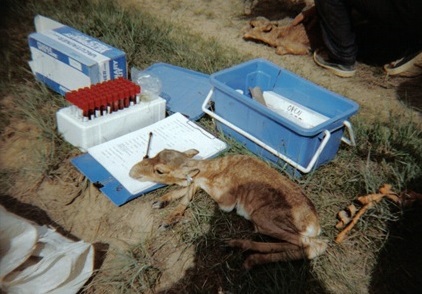First blog from the field, by Eric Morgan
Hello, I’m on the train… converging on Heathrow today you might see handful of people lugging microscopes, test tubes and camping paraphernalia – on their way to join an ACBK-led expedition to last year’s saiga die-off sites.
There, we hope to learn more about what caused the dramatic events of May 2015. Above all, we hope to see surviving saigas, we hope to see calves being born, and we hope not to see unusual levels of sickness or death. Beyond that, the data and samples we aim to gather will give a more complete picture of the local vegetation and other features at the sites during calving, which was impossible to survey fully last year, as well as the normal health status and bacterial and parasitic fauna of saigas at this time.
A parallel trip to the western Ural population will help to build understanding of normal health parameters in a saiga population (hopefully) not experiencing a die-off event. Livestock keepers will be asked about the health of their animals, in general and last spring, and the numbers, distribution and health precautions taken for their animals. While livestock disease is not currently implicated in last year’s saiga die-offs, remaining saigas are vulnerable to any new disease burden, and engaging farmers could help to provide early warning of such threats and the means to head them off.
Personally, it is nearly 20 years since I stood in the middle of a saiga calving aggregation, then in Ustiurt, and listened to tens of thousands of these most gentle and amazing creatures bringing life to the steppe. This year, in Betpak-Dala, I am preparing for a more silent experience: let’s hope the silence is temporary.
We’ll keep you posted when we can, but for now, this service is arriving at its final destination, please remember to take your personal belongings with you when you leave the train…
Featured image: Surveying saiga calf health in Ustiurt, May 1998. Photo by Eric Morgan
Dr. Eric Morgan is a professor of Veterinary Parasitology at the University of Bristol School of Biological Sciences.

